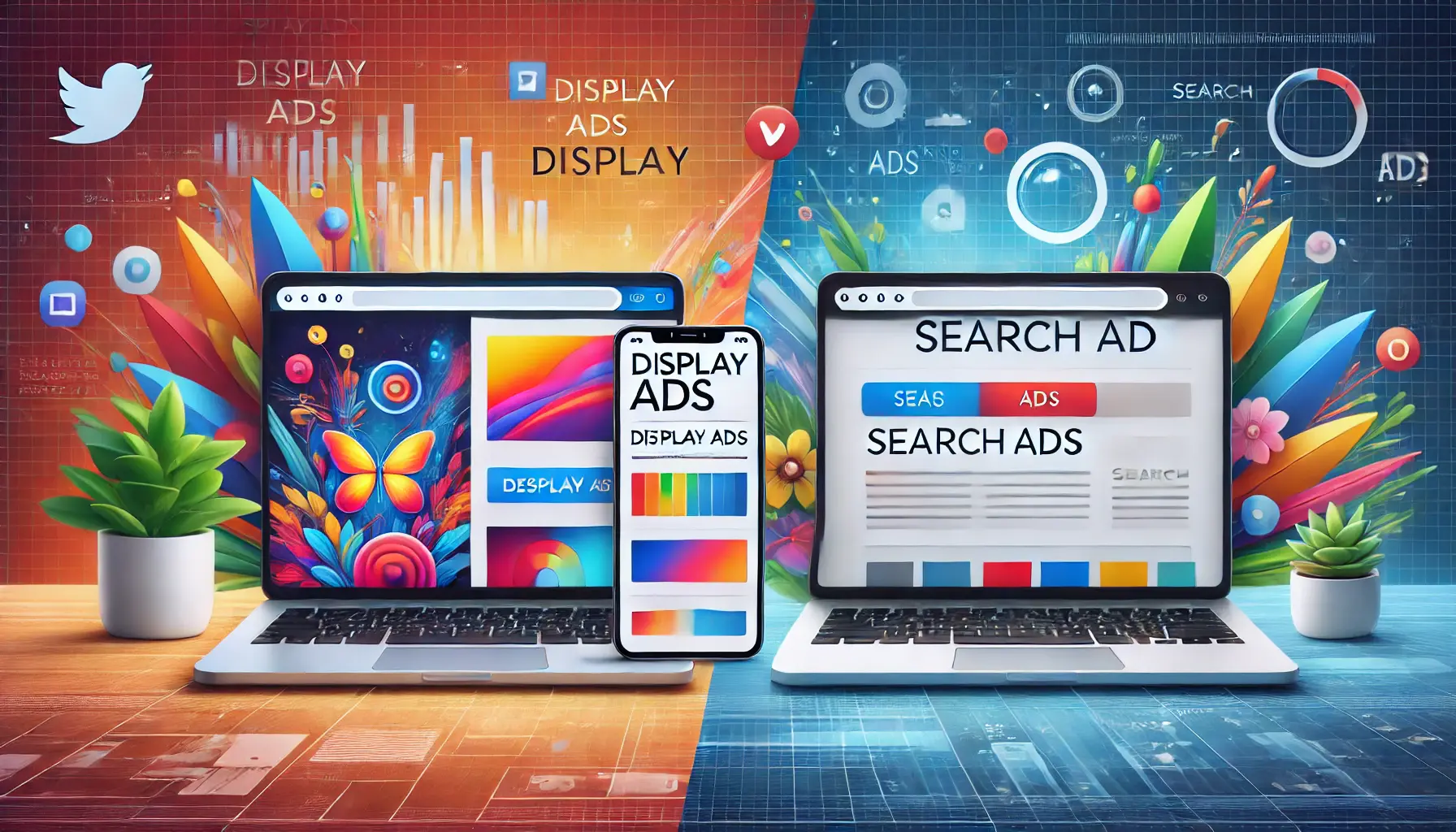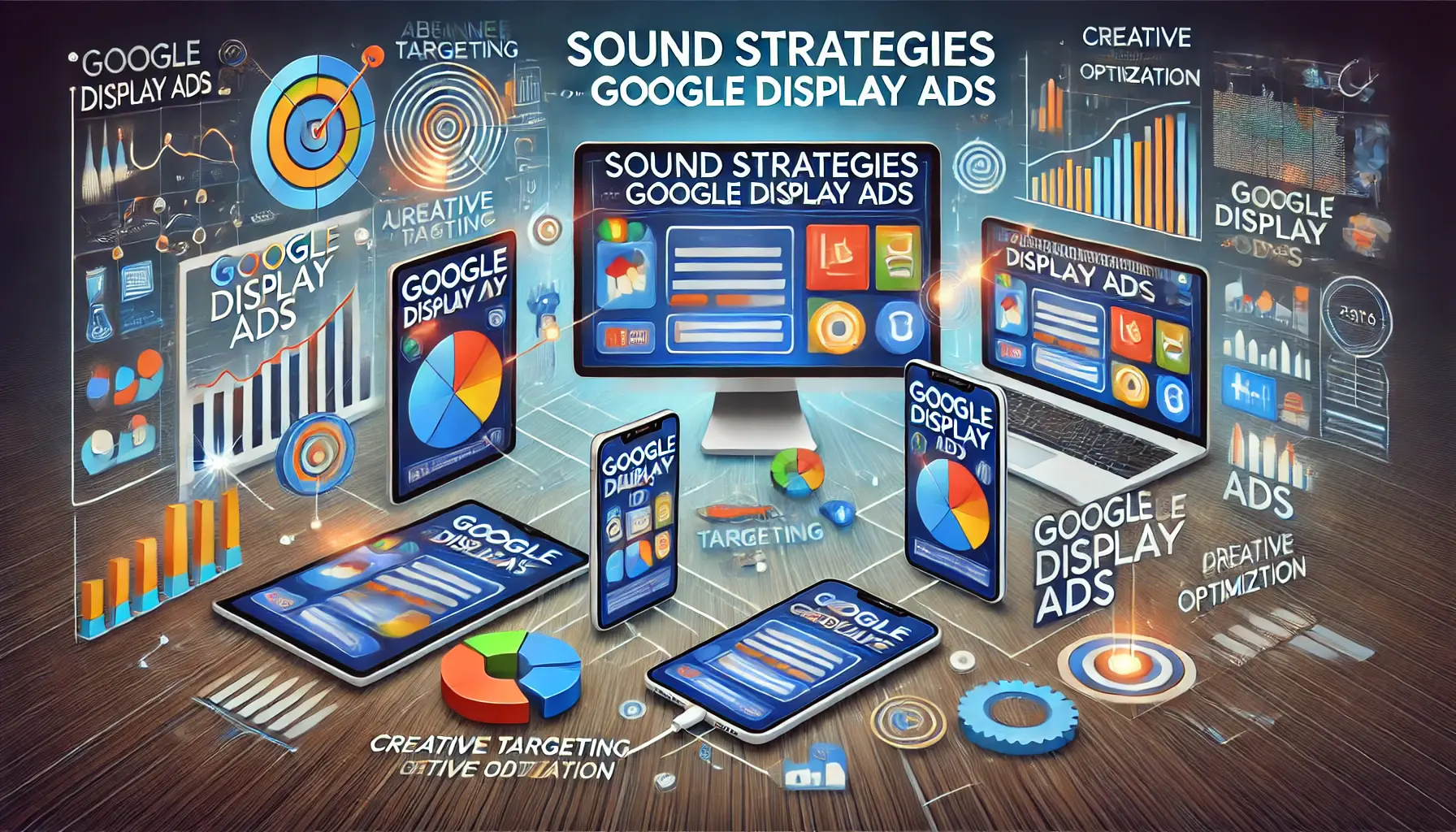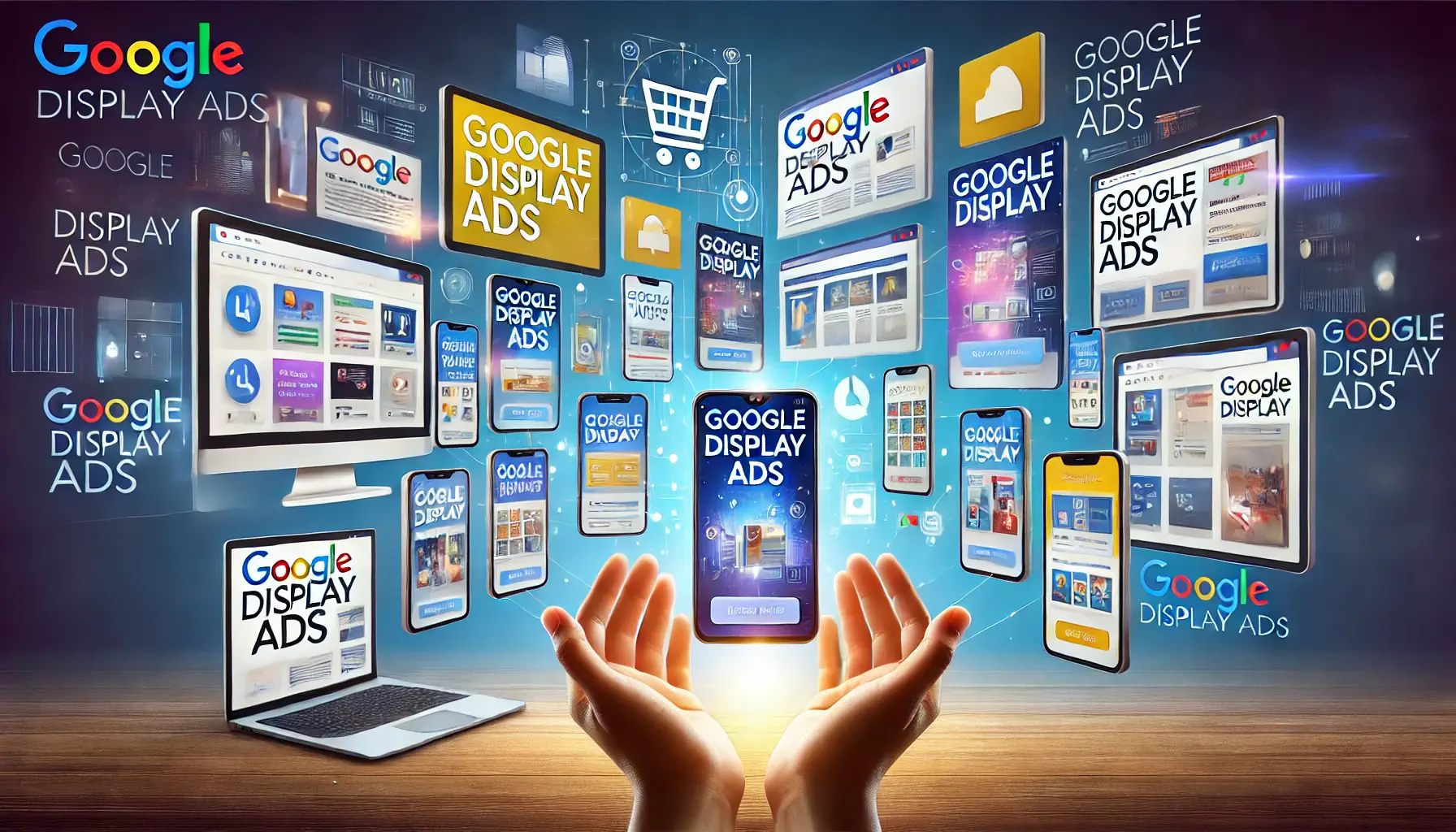Looking to up your digital marketing game?
For any business, the starting point for getting better should be understanding Google Display Ads.
These ads let you reach your clients on over 3 million websites and apps, plus popular platforms like YouTube and Gmail.
By mastering the basics, you can effectively promote your business and achieve your marketing goals.
- Understanding the Basics of Google Display Ads
- Targeting Techniques for Maximum Impact
- Crafting Creative and Engaging Ad Designs
- Optimizing Campaign Performance for Google Display Ads
- Advanced Techniques for Refining Your Google Display Ads
- Summarizing the Sound Strategies for Google Display Ads
- Google Display Ads: Frequently Asked Questions
Understanding the Basics of Google Display Ads
Before diving into advanced strategies, it’s essential to grasp the fundamentals of Google Display Ads.
This knowledge will serve as the foundation for creating successful campaigns.

An engaging representation of Google Display Ads featuring interconnected digital devices displaying vibrant advertisements.
What Are Google Display Ads?
Google Display Ads are visual advertisements that appear across the Google Display NetworkA collection of over 3 million websites, apps, and Google-owned platforms where Display Ads can appear.—a vast collection of websites, apps, and Google-owned properties.
Unlike text-based search ads, display ads can include images, videos, and rich media to capture the audience’s attention.

A visual comparison of Display Ads and Search Ads highlighting their distinct characteristics.
How Display Ads Differ from Search Ads
While both are part of Google Ads, display ads and search ads serve different purposes:
- Search Ads: Appear on search engine results pages when users actively search for specific keywords.
- Display Ads: Appear on various websites and apps, targeting users based on their interests, demographics, and browsing behavior.
This distinction allows display ads to create awareness and interest even when users aren’t actively searching for products or services.

A dynamic visualization of Display Ads emphasizing their role in digital marketing.
The Role of Display Ads in Digital Marketing
Display ads play a vital role in digital marketing by:
- Building Brand Awareness: Reaching a broad audience to increase recognition.
- Retargeting Potential Customers: Reminding users who have previously visited your site to return and complete desired actions.
- Supporting Lead Generation: Attracting potential customers through compelling visuals and messages.

A conceptual depiction addressing myths about the accessibility and effectiveness of Google Display Ads.
Common Misconceptions About Google Display Ads
There are several misconceptions about display ads that can hinder their effective use:
- Myth: Display ads are only for large businesses with big budgets.
- Fact: Businesses of all sizes can benefit from display ads by setting appropriate budgets and targeting strategies.
- Myth: Display ads don’t drive conversions.
- Fact: With proper targeting and compelling creatives, display ads can lead to significant conversions.
By understanding these basics, you’re well on your way to leveraging Google Display Ads to enhance your marketing efforts.
Ready to dig deeper?
In the next section, let’s look into targeting techniques in detail.
Understanding the fundamentals of Google Display Ads is the cornerstone of successful digital marketing campaigns. By mastering these basics, advertisers can build a solid foundation for advanced strategies.

A professional depiction of strategic targeting techniques for effective digital advertising.
Targeting Techniques for Maximum Impact
Effectively reaching your desired audience is crucial for the success of your Google Display Ads campaigns.
By employing advanced targeting techniques, you can ensure your ads resonate with the right users, enhancing engagement and conversion rates.

A vibrant representation of audience segmentation strategies for effective display advertising.
Audience Segmentation for Display Ads
Segmenting your audience allows you to tailor ads to specific groups, increasing relevance and effectiveness.
Consider the following segmentation strategies:
- Demographic Targeting: Focus on age, gender, income, and other demographic factors to reach the most relevant audience.
- Geographic Targeting: Deliver ads to users in specific locations, from countries to cities or even a defined radius around a point.
- Interest Targeting: Reach users based on their interests and online behaviors, aligning your ads with their preferences.

A visual representation of remarketing strategies to enhance conversions in digital advertising.
Using Remarketing to Boost Conversions
Remarketing involves targeting users who have previously visited your website or app.
This technique keeps your brand top-of-mind and encourages return visits.
Implement remarketingA strategy to re-engage users who have previously interacted with your website or app. by:
- Creating Remarketing Lists: Develop lists of users based on their behaviors, such as page visits or abandoned shopping carts.
- Customizing Ads: Design ads that address the specific interests or needs demonstrated by the user’s prior interactions.
- Setting Frequency Caps: Limit the number of times your ads are shown to prevent ad fatigue and annoyance.

A representation of contextual targeting showcasing relevant ads on aligned web page content.
The Importance of Contextual Targeting
Contextual targeting places your ads on websites or pages with content related to your product or service.
This relevance increases the likelihood of user engagement.
To implement contextual targetingPlacing ads on websites with content related to your product or service.:
- Select Relevant Keywords: Choose keywords that align with your offerings to match your ads with appropriate content.
- Utilize Topic Targeting: Opt for broader categories that fit your industry to reach a wider yet relevant audience.
- Monitor Placement Performance: Regularly review where your ads appear and adjust keywords or topics to improve results.

A dynamic visualization of leveraging lookalike audiences to expand reach in advertising.
How to Leverage Lookalike Audiences
Similar Audiences, more popularly called lookalike audiencesNew user groups similar to your existing audience, created using shared characteristics. in other advertising platforms, enable you to target new users that resemble your existing customers.
This automatically broadens your targeting to reach an audience that could be highly responsive.
To begin leveraging lookalike audiences:
- Analyze Customer Data: Identify patterns or commonalities among your top customers and use this insight to inform creating similar audiences.
- Apply Similar Audience Targeting: Let Google’s Similar Audiences feature automatically find new users that are similar to your existing audience.
- Test and Refine: Continuously monitor the performance of your ads with similar audiences and make necessary adjustments to enhance effectiveness.
Applying these techniques will significantly amplify the effectiveness of your Google Display Ads, ensuring they reach and impact only the most relevant audience bases.
Next, we’ll explore the art of creating captivating display ads to engage and drive action in your campaigns.
Effective targeting is key to maximizing the impact of your campaigns. Techniques like audience segmentation, remarketing, and contextual targeting ensure your ads resonate with the right audience.

A visually rich depiction of crafting engaging ad designs for effective digital marketing.
Crafting Creative and Engaging Ad Designs
Designing compelling Google Display Ads is essential to capture your audience’s attention and drive engagement.
By focusing on best practices and leveraging the latest trends, you can create ads that stand out in the crowded digital landscape.

A professional depiction of best practices in display ad design with polished and engaging layouts.
Best Practices for Display Ad Design
To maximize the effectiveness of your display ads, consider the following strategies:
- Use High-Quality Images: Ensure that the images are clear, professional, and relevant to your brand. High-resolution images boost credibility and command attention.
- Consistency in Branding: Use consistent colors, fonts, and logos to make ads instantly recognizable and reinforce brand identity.
- Include a Clear Call-to-Action (CTA): Encourage user interaction by including concise and clear CTAs, such as ‘Shop Now’ or ‘Learn More.’
- Optimize for Multiple Formats: Create different sizes and formats for advertisements to reach users across various devices and platforms. Responsive display ads automatically resize themselves to fit the ad space provided.

A creative visualization of how visuals and copy work together to enhance engagement in digital ads.
The Role of Visuals and Copy in Engagement
Balancing visuals and text is critical for effective communication:
- Concise Messaging: Text should be brief and impactful, conveying a key benefit or offer. Overloading ads with information can overwhelm viewers.
- Eye-Catching Visuals: Use images or graphics that evoke emotion and relate to your product or service, making the ad more memorable.
- Readable Fonts: Select fonts that are easy to read across all devices and backgrounds, ensuring accessibility.

A visual representation of popular ad sizes and formats used in digital advertising.
Ad Sizes and Formats That Perform Best
Some ad sizes have been proven to work better because of their visibility and placement options.
According to Google’s best practices, the top-performing ad sizes include:
- Medium Rectangle (300×250): Versatile and commonly used across various placements.
- Large Rectangle (336×280): Provides more space for content and visuals.
- Leaderboard (728×90): Works best when placed at the top of the page.
- Half Page (300×600): Offers ample space for engaging visuals and messaging.
- Large Mobile Banner (320×100): Optimized for mobile devices, ensuring reach to mobile users.
Utilizing these sizes can enhance ad performance by aligning with common website layouts and user behaviors.

A professional representation of A/B testing in digital advertising with ad variations on multiple devices.
Tips for A/B Testing Display Ads
Regular testing allows you to identify what resonates best with your audience:
- Test One Element at a Time: Change only one component per test, such as the headline, image, or CTA, to accurately determine its impact.
- Use Sufficient Sample Sizes: Run tests long enough to gather meaningful data, avoiding premature conclusions.
- Analyze Performance Metrics: Focus on key indicators like click-through rates (CTR) and conversion rates to assess effectiveness.
- Implement Winning Variations: Once a clear winner is identified, apply the successful elements to future ad designs.
By adhering to these design principles and continuously testing your ads, you can create compelling Google Display Ads that engage your target audience and drive desired actions.
In the next section, we’ll explore strategies for optimizing campaign performance to ensure you achieve the best possible results.
Captivating ad designs are essential for grabbing attention. High-quality visuals, consistent branding, and clear calls-to-action are crucial for effective Google Display Ads.

A visual representation of optimizing campaign performance for Google Display Ads with key metrics and devices.
Optimizing Campaign Performance for Google Display Ads
Enhancing the performance of your Google Display Ads campaigns is essential to maximize return on investment (ROI) and achieve your marketing objectives.
By implementing strategic optimizations, you can improve ad efficiency, reach, and engagement.

A visual representation of monitoring and excluding underperforming ad placements in digital marketing.
Monitor and Exclude Underperforming Placements
Regularly reviewing where your ads appear helps identify placements that do not yield desired results.
To manage these placements:
- Review Ad Placements: In your Google Ads account, navigate to your display campaigns, select ‘Placements,’ and then ‘Where Ads Showed’ to see all sites and apps displaying your ads.
- Exclude Low-Quality Placements: Identify sites with high impressions but low engagement or conversions and exclude them to prevent budget wastage.

A visual representation of leveraging audience targeting and segmentation in digital advertising.
Leverage Audience Targeting and Segmentation
Refining your audience targeting ensures that your ads reach users most likely to engage.
Consider the following strategies:
- Custom Audiences: Create custom audiences based on specific interests or behaviors relevant to your product or service.
- Remarketing Lists: Target users who have previously interacted with your website or app to encourage return visits and conversions.

A visual representation of implementing effective bidding strategies in digital advertising.
Implement Effective Bidding Strategies
Choosing the right bidding strategy can significantly impact your campaign’s success.
Options include:
- Target CPA (Cost Per Acquisition): Automatically sets bids to help get as many conversions as possible at the target cost per action you set.
- Maximize Conversions: Automatically sets bids to help get the most conversions for your campaign while spending your budget.

A visual representation of utilizing Google’s AI-powered tools in digital advertising.
Utilize Google’s AI-Powered Tools
Google offers AI-driven features to enhance campaign performance:
- Performance Max Campaigns: Apply Google’s AI to optimize bids and placements across Search, Display, and YouTube to drive better results. Upgrading to Performance Max has resulted in significant lifts in conversions for advertisers while maintaining a healthy CPA.
- Optimized Targeting: Use optimized targeting to reach new and relevant audiences most likely to convert within your campaign goals. This feature helps identify potential customer segments, boosting your campaign’s performance.

A visual representation of conducting A/B testing for continuous improvement in digital ad performance.
Conduct A/B Testing for Continuous Improvement
Regular testing allows you to identify what resonates best with your audience:
- Test One Element at a Time: Change only one component per test, such as the headline, image, or CTA, to accurately determine its impact.
- Use Sufficient Sample Sizes: Run tests long enough to gather meaningful data, avoiding premature conclusions.
- Analyze Performance Metrics: Focus on key indicators like click-through rates (CTR) and conversion rates to assess effectiveness.
- Implement Winning Variations: Once a clear winner is identified, apply the successful elements to future ad designs.
Applying the above optimization strategies will help bring out the best in your Google Display Ads campaign, ensuring they serve and engage your target audience effectively.
Next, we will discuss advanced techniques for refining your advertising efforts further.
Regular campaign optimization, including excluding underperforming placements, leveraging advanced targeting, and using AI-powered tools, is vital for driving better results and ROI.

A visual representation of advanced techniques for refining Google Display Ads using AI, remarketing, and cross-platform management.
Advanced Techniques for Refining Your Google Display Ads
To stay ahead in the evolving digital advertising landscape, it’s essential to adopt advanced strategies that enhance the effectiveness of your Google Display Ads.
By leveraging the latest tools and trends, you can create more personalized and impactful campaigns.

A futuristic depiction of AI-powered automation in digital advertising optimizing ad strategies.
Embrace AI-Powered Automation
Artificial intelligence is transforming digital advertising through automation and optimization of campaign management.
With the implementation of AI-driven solutions, advertising has become more effective and efficient:
- Performance Max Campaigns: With Google’s Performance Max campaigns, automatically distribute your budget across Search, Display, YouTube, and Discover to reach the right customer at the right moment for maximum conversions.
- Smart Bidding: Implement machine learning algorithms that adjust your bids in real-time based on the likelihood of conversion, ensuring optimal budget allocation.

A visual representation of leveraging video advertising across various digital devices.
Leverage Video Advertising
With the increasing consumption of video content, incorporating video ads into your strategy can significantly boost engagement and brand awareness.
- YouTube Shorts Ads: Capitalize on the popularity of short-form video content by creating concise and compelling ads that quickly capture attention.
- Interactive Video Ads: Develop ads that encourage user interaction, such as clickable products or polls, to enhance engagement and drive conversions.

A visual representation of privacy-first advertising with an emphasis on user consent and data security.
Prioritize Privacy-First Advertising
As privacy regulations become more stringent, adopting strategies that respect user privacy while delivering relevant content is crucial.
- First-Party Data Utilization: Build and leverage your own data to create personalized ad experiences without relying on third-party cookies.
- Consent Management: Follow privacy regulations, clearly offer ways to give consent, and respect user choices to maintain compliance.

A visual representation of running cross-platform campaigns across multiple digital devices and platforms.
Run Cross-Platform Campaigns
Create cohesive experiences across multiple platforms for better brand recall and to reach more users.
- Omnichannel Strategies: Develop campaigns that seamlessly connect the experiences of social media, email, and display advertising.
- Integrated Analytics: Leverage unified analytics tools to track performance across platforms and make data-driven adjustments where needed.
Integrating these advanced techniques into your Google Display Ads strategy will enable you to run more effective, compliant campaigns that resonate with your target audience and adapt to the dynamic digital advertising environment.
Adopting advanced strategies such as AI-powered automation, video advertising, and privacy-first approaches helps stay ahead in the competitive digital marketing landscape.

A visual representation summarizing sound strategies for Google Display Ads with integrated devices and key strategies.
Summarizing the Sound Strategies for Google Display Ads
Google Display Ads offer unparalleled opportunities to reach diverse audiences and drive engagement.
By implementing sound strategies, businesses can optimize their campaigns, maximize ROI, and achieve their marketing objectives effectively.
This article explored a range of techniques to help advertisers make the most of Google Display Ads.

A visual representation of key takeaways from digital advertising strategies with diverse devices and performance metrics.
Key Takeaways from the Strategies
Throughout this guide, we covered some key components of Google Display Ads.
Following is a quick rundown of the most important strategies one can follow:
- Understand the Basics: It’s critical to understand how Google Display Ads work. This helps businesses tailor their campaigns to meet their goals.
- Target for Maximum Impact: Advanced audience segmentation, remarketing, and contextual targeting lie at the heart of reaching the right user at the right time.
- Craft Engaging Designs: Top-notch visuals, concise messaging, and clear CTAs are imperative to drive user attention and interaction with the ad.
- Optimize Campaign Performance: Periodic performance reviews, smart bidding strategies, and leveraging AI-powered tools go a long way in enhancing campaign performance.
- Advanced Techniques: Leveraging cross-platform campaigns, prioritizing privacy-first advertising, and adopting AI-driven automation help businesses stay ahead in a competitive digital landscape.

A visual representation of why sound strategies matter in digital advertising, highlighting successful campaigns and key metrics.
Why Sound Strategies Matter
Implementing sound strategies is not just about following best practices—it’s about adapting to a dynamic environment where consumer behavior, technology, and market trends are constantly evolving.
With the right approaches, advertisers can:
- Build brand awareness by reaching wider, relevant audiences.
- Drive conversions through personalized and impactful messaging.
- Maximize budgets by using data-driven insights and smart tools.
- Ensure compliance with privacy regulations while delivering value to users.

A visual representation of taking the next steps in digital advertising with a pathway leading to new opportunities.
Taking the Next Steps
Your mastery of Google Display Ads starts with a commitment to learn and adapt.
Regular campaign performance review, experimentation with the newest techniques, and staying updated on the latest digital marketing trends are essential to drive maximum value from Google Display Ads and achieve measurable business growth.
The key to success lies in adopting good practices and using modern techniques to transform Google Display Ads into powerful tools for achieving marketing success.
Whether it be a small business or an enterprise, display advertising is an avenue that can make a significant difference when executed effectively.
Implementing sound strategies ensures that Google Display Ads effectively build brand awareness, drive conversions, and maximize budget utilization, adapting to ever-changing market trends.

A visual representation of frequently asked questions about Google Display Ads, featuring devices and common inquiries.
Your campaigns can be managed by an agency specialized in Google Ads, check out our service page.
Google Display Ads: Frequently Asked Questions
Google Display Ads can be a bit tricky to understand.
Here are some common questions that will help explain the main facts.
Google Display Ads are visual ads shown on the Google Display Network, which includes websites, apps, and Google-owned properties such as YouTube and Gmail.
Display Ads are visual and run across multiple ad platforms, targeting users’ interests and behaviors, while Search Ads are text-based and shown in response to targeted keyword queries.
The GDN is a network of over 3 million websites, apps, and Google properties where your Display Ads can appear, offering enormous reach across the internet.
Utilize targeting options like demographic, geographic, interest-based, and contextual targeting to effectively reach specific audience segments.
Responsive display ads automatically adjust their size, appearance, and format to fit available ad spaces, combining your assets to create optimal ads for various placements.
Use metrics like click-through rates (CTR), conversion rates, impressions, and engagement to assess ad performance and make data-driven optimizations.
Remarketing involves targeting users who have previously visited your website or app, encouraging them to return and complete desired actions.
Focus on high-quality visuals, concise messaging, consistent branding, and compelling calls-to-action to create engaging and effective Display Ads.
Utilize strategies like Target CPA, Maximize Conversions, and Smart Bidding to let Google optimize bids based on your campaign goals and performance data.














